As Higher Education Leaders Wait for Slow-to-Arrive Federal Relief, Students Are Taking Charge of Providing Key Services to Their Classmates & Communities
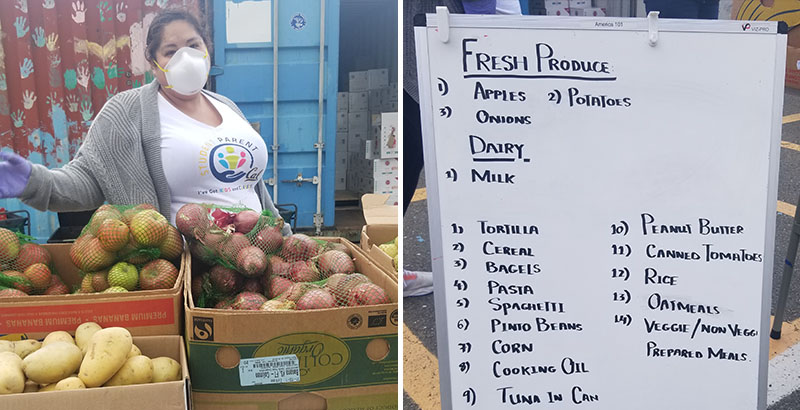
Last month’s historic $2.2 trillion stimulus package earmarks $14 billion to higher education, but when that money will actually reach colleges and schools is anyone’s guess. As they wait for those dollars to land, institutions are now tapping into their coffers and donation networks to supply students with crucial financial assistance.
“What we thought we could do best was move money immediately,” said Geoff Green, chief executive officer of the Santa Barbara City College Foundation, the philanthropic arm of the community college in California. The foundation began taking student applications for aid March 30 and doled out about $1.4 million to 1,600 students after its first week.
Green views the support — up to $1,000 per student — as a bridge to carry students from the economic consequences of the coronavirus pandemic to whenever federal stimulus dollars, including expanded unemployment insurance and one-time checks of up to $1,200, begin circulating.
“Our greatest fear is that once this wave of challenges hits a student who’s already on the economic margins, the easiest thing to do is simply to drop out of school and handle the other issues first,” Green said.
Federal response
It’s not clear if the U.S. Department of Education will prioritize sending the $14 billion out quickly or take time to create guidelines and regulations first, before the funds are released.
“We hope if they err, they err on the side of getting the money out quickly,” said Terry Hartle, senior vice president of government and public affairs for the American Council on Education, the nation’s largest higher education advocacy group.
Last Thursday, the ACE, along with dozens of other organizations, sent a letter to the department imploring it to release funds soon.
“I fear this funding will be for naught for many institutions unless the Department can act very quickly to make these funds available,” said the letter’s author, ACE president Ted Mitchell, former under secretary of education overseeing higher education for the Obama administration. The National Governors Association joined the fray Friday, sending the department a letter urging it to distribute the funds within two weeks.
The financial strain on higher education institutions has been enormous. With classes taking place virtually, the sources of income colleges typically rely on, such as parking fees, events rentals and other on-campus revenues, are dried up. Colleges are also reimbursing students for housing costs as many have fled their dorms, either because the institution ordered it or because students wanted to be closer to their families. Some students have even been reimbursed for tuition.
“Every college in the country is facing an immediate cash-flow crisis,” Hartle said during a webinar with reporters organized by the Education Writers Association last week. “When revenue does not come when new expenses like refunds get added unexpectedly, they play havoc with the budgets.”
While about half of the $14 billion committed to higher education is reserved for direct student aid, colleges would like to see some of the money they’ve spent on student support reimbursed.
“It will be very helpful to know if the funding for emergency grants to students can be used to reimburse institutions for students’ expenses, such as housing, food, transportation, equipment and the like, that already have been or may soon be refunded or incurred on behalf of students,” Mitchell’s letter said.
(Update 4/9/2020: On April 9, one day after the publication of this piece, the U.S. Department of Education released a list of how much each college would get through the stimulus. It also noted that colleges cannot use money meant for students to reimburse themselves for the emergency aid they already sent to students.)
The hit to students
Many of these students, especially those in community colleges, were already economically disadvantaged well before the spread of the novel coronavirus decimated the nation’s economy. At California’s community colleges, for example, 41 percent of the 2.3 million students who attend them receive tuition waivers because they come from low-income households, earning around $37,000 for a family of four.
Now the often nonacademic campus services students typically relied on for basic needs — food pantries, computer labs and campus internet — are largely inaccessible.
Alexis Zaragoza, 22, the student representative on the California Community Colleges Board of Governors, the body that oversees the 115-college system, said she has been pushing leadership to adopt commitments to students that address basic needs, such as lost access to food pantries, internet connectivity, computers and study areas. The board last month approved greater powers for system chancellor Eloy Ortiz Oakley, including overriding individual college rules, which his office has already used to loosen regulations on student grades and refunds on student fees during this pandemic.
“I know that he’s very concerned about not stepping on colleges’ toes too much,” Zaragoza said, but the diversity of responses from campuses “is very confusing for students, and it just creates more inequity.” She wants to see a list of priorities that Oakley encourages all colleges to honor. “We need to do something about Wi-Fi and laptops. We need to do something about food services,” Zaragoza said.
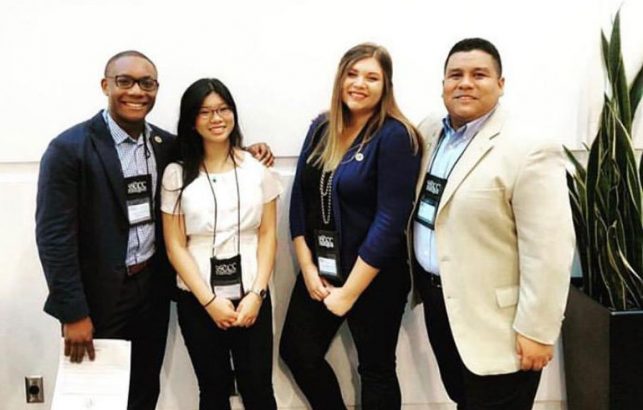
Amine El Moznine, 20, the vice president of legislative affairs for the Student Senate for California Community Colleges, who attends one of the system’s colleges, gives Oakley’s team good marks for its engagement with the student government.
The senate has asked the system’s leadership for many of the basic-needs investments for which Zaragoza has advocated, including continuing to pay students who had campus jobs even though virtually all campuses are closed. If the money for student employment “was already allocated at the beginning of the year … it should be sent over to the students,” Moznine said. He calls it a “straightforward way” to help those students specifically. But more direct financial support to all students is top of mind for the senate, he added.
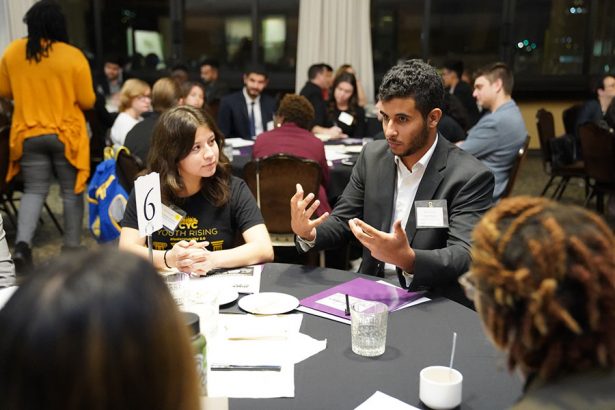
Another item on the wish list is improved coordination among the three systems of public higher education in California, plus its private nonprofit colleges. When Oakley announced greater flexibility for students to take their classes as pass/no-pass rather than as fully graded courses to mitigate the disruptive shift to online learning, the move came with the caveat that the University of California and California State University systems may not accept those courses for transfer students. A week later, both systems announced that they would, but that students had to wait at all for those flexibilities is a sign to Moznine that there should be more statewide collaboration.
Adding to the pressure on students are the millions of job losses that are crippling family finances. The migration from dorms to their parents’ or guardians’ homes has also added to the emotional strain on students, who now must find space to focus on their studies in cramped dwellings. Students who are parents must contend with the added pressures of raising their children as the pandemic intensifies. Mental health in some cases has to take a back seat as students struggle to find calm environments to share personal details with therapists, if a virtual session is even possible.
“It’s usually one of the only times that you can truly be human as a parent because you don’t have to worry about talking about tough topics or crying or being frustrated or showing any emotions that might otherwise scare your child,” said Sadia Khan, 24, a single parent with a 4-year-old son, who is in her final year as an undergraduate at the University of California, Berkeley. Now that the state is under orders to stay at home, “that’s not possible,” she said over the clanks and clamors of her child.
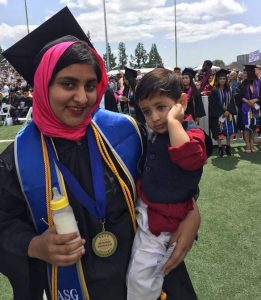
The coronavirus crisis couldn’t come at a worse time for Khan. Paradoxically, a 2019 state grant for student parents has resulted in Khan’s receiving a smaller housing allowance from UC Berkeley this year. She’s now short on rent, and her 15-hours-a-week job at UC Berkeley’s Student Parent Center, which is still open virtually amid the crisis, brings in $15.59 an hour. She’s also witnessed a spike in food costs since the pandemic led to shelter-in-place orders in her county. Before, the $355 a month she received in SNAP benefits — the federal term for food stamps — sustained her. That’s no longer enough, she said.
Khan also volunteers 20 hours weekly to run a food pantry for students who have children themselves. While other campus food pantries have shuttered because of public health reasons or donors pulling out, the one she helps to manage gets supplies from the university, the county and a city nonprofit. It’s open twice weekly and regularly feeds about 500 people, Khan said, including herself. “We’re relying on those heavily ourselves,” she said. On Friday, according to Khan, the pantry distributed food to 70 people in the first 30 minutes of opening.
Colleges and their philanthropies are distributing vital resources, but roadblocks remain
Philanthropy has been a lifeline for students seeking vital resources, such as laptops, internet connections and food.
Los Angeles Community College District, one of the nation’s largest, with nine colleges that educate nearly a quarter of a million students annually, had by early this week received more than 9,000 applications from students in need of Chromebooks, affordable laptops made by Google. They’ve become increasingly crucial for student academic success as classes have moved online and campus libraries remain closed.
By April 7, The Foundation for the Los Angeles Community Colleges had distributed more 2,000 Chromebooks since the COVID-19 crisis began, said William H. Boyer, a spokesperson for the district. Because of health risks and to speed up the process, the laptops will now be sent to students by mail rather than through pick-up points.
The demand for electronics, however, has put a run on prices. The district has reached out to other vendors to purchase more laptops, but they’re quoting prices that are three times as high as the district’s current vendor for the same type of computer, Boyer said.
Individual colleges in the district and their own foundations are also distributing Chromebooks to students, either by purchasing them or by finding unused ones that were meant for students in the fall. The district is scouring its local, state and federal resources to come up with additional funds to fulfill the remaining technological needs of students, which keeps growing daily. Boyer said Thursday that the district was receiving a $100,000 gift from the Ballmer Group, whose co-founder Steve Ballmer is owner of the Los Angeles Clippers franchise in the NBA.
For students lacking reliable internet access, the district is pointing them to local telecom companies that are promising free or discounted wireless internet.
Although California Gov. Gavin Newsom announced a partnership with Google to distribute 100,000 wireless hotspots to students primarily in rural areas, the program applies only to K-12 students, not those in college, a spokesperson for the governor confirmed.
One California community college, the online-only Calbright College, is mailing 500 Chromebooks and 500 T-Mobile hotspots to community colleges in rural areas for use through the summer. The gesture was born out of a weekly webinar the system’s chancellor’s office conducts to inform hundreds of college faculty and staff about emergency rule updates to academics and finances, plus changing state and federal regulations. There, the college learned that students of rural campuses were asking for devices and hardware. Calbright officials followed up with those schools “so that we’re not just putting things out there without meeting a need,” said Calbright spokesperson Taylor Huckaby.
Some of the Los Angeles district’s colleges are discussing providing wireless internet access points on their campus parking lots, but that introduces new challenges, including enforcing social distancing among students and providing security. Los Angeles Trade -Technical College, part of the district, has considered this approach. One sticking point is access to power for a large number of laptops; the parking structure the school has in mind doesn’t have many outlets, and there’s a fear that students will huddle around the few that are available.
Los Angeles-area community colleges should also be prepared to provide their physical spaces to health officials who may need new areas to place hospital beds as the pandemic in California worsens. The prospect of patients receiving treatment on campus may be at odds with providing space for students to access the internet.
Food pantries have also largely shuttered because enforcing social distancing orders while providing food is difficult and the charities that provided the food are no longer able to do so. The student need is high. A 2016 survey found that among the students who responded, more than 60 percent reported experiencing food insecurity, a measure of hunger.
Supermarket company Kroger did donate $150,000 to the district to be used as $50 gift cards, for which students had to apply through their student portals. The district encountered some problems with how the application for the food gift card was being shared on those portals, appearing in different places. Moreover, “the system is so overloaded right now” with students seeking laptops and food cards that students reported being unable to apply, Boyer said on Thursday. “We’ve encouraged people to just go back and try again.”
‘Philanthropy is not rising to the moment yet’
Statewide, students experienced site crashes and technical issues with a fund administered by Mission Asset Fund that on April 2 promised $500 per student for undergraduates at public universities and colleges in California. Despite the eligibility rules — students had to be enrolled full time and have completed a year’s worth of studies — around 50,000 applicants ended up on a waiting list before the fund announced it was no longer taking applications less than 24 hours later.
Jose L Medina III, a full-time student at California State University, Fresno, attempted to submit an application on the afternoon of April 2 but encountered error messages, posting one to Twitter. A representative from College Futures, a donor to the fund, responded to the tweet by writing that if he had already begun his application, he wouldn’t lose his spot in line. On Friday, he was locked out of the system and wasn’t sure if his application went through.
I keep getting this error? Does this mean we can no longer apply? pic.twitter.com/ystIJCV4UX
— Jose Medina III (@JMedinaIIIEDU) April 2, 2020
Speaking broadly, Green, of the Santa Barbara City College Foundation, believes that “philanthropy is not rising to the moment yet. So institutions that have dollars in their possession, the time to deploy them was yesterday.”
The foundation supporting Cuesta College, a community college near San Luis Obispo in California’s central coast region, doubled its cap on grant requests to $1,000 from $500 because almost 80 percent of the college’s students were employed, and the main industry in the area is the hard-hit tourism and hospitality sector.
To maximize aid, the foundation is running its grants through the college’s financial aid office so that staff there can check whether the students qualify for any other financial support. Students do have to show a pay stub with loss of hours, said the foundation’s president, Shannon Hill.
“The foundation staff are stepping up to the plate to get checks out (and donor checks in), so there are only slight delays in our processing,” she wrote in an email last week.
Fast movement of direct student aid will be an even bigger challenge once the federal stimulus money comes through. Meanwhile, the injection of capital will place new burdens on college staff to determine student eligibility.
David Helene, founder and CEO of Edquity, a student financial success and emergency aid company, thinks his company will play a useful role in distributing the emergency aid on behalf of colleges. The stimulus law, known as the CARES Act, allows for third parties like Edquity to help colleges administer the funds. Edquity has already made a name for itself doing just that, using an algorithm that asks students a short amount of questions to determine their eligibility for emergency aid. The application is based on research done by Sara Goldrick-Rab, a leading scholar on student basic needs who joined Edquity in a senior role last year.
In addition to an arrangement with the Dallas County Community College District struck last year to distribute $500,000 in emergency aid, Helene said his company has agreements in place with several colleges and charities already, and he expects more will join soon.
“One of the big challenges that we see practitioners dealing with is how do they effectively ration this money and how do they make decisions among a pool of students, all of whom, based on need, should have access to the funds,” he noted. Already in March, hundreds of schools have contacted Edquity about its services, Helene said, a 30-fold increase of the number of schools that reach out to the company.
The transition to online poses other challenges for students
Some basic-needs support requires more than just dollars. Gilbert Vasquez, 57, is a member of the Formerly or Currently Incarcerated Students program at East Los Angeles College; he helps fellow students adjust to virtual learning. Vasquez spent about a decade incarcerated and is enrolled part time at the college himself. He assists students who have moved out of the criminal justice system by hopping on the phone and walking them through the online instructional portals that are necessary for keeping up with courses now that classes have moved online.
“A lot of us come out of incarceration, our past life, not too computer-friendly,” said Vasquez, who also works full time at a substance-abuse residential facility as a counselor.
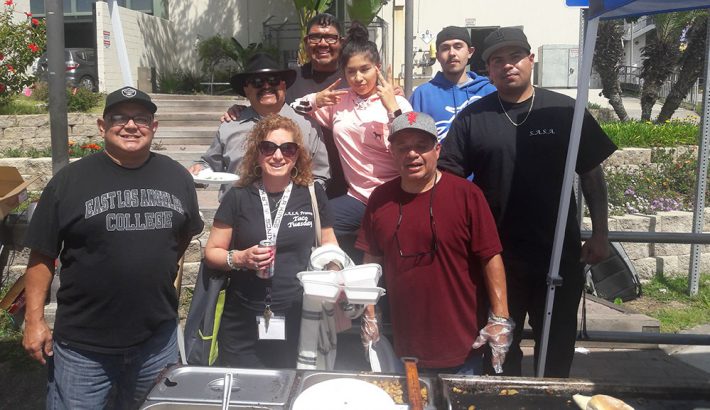
The transition to online hasn’t been smooth for him either. Beyond the anxieties of a city under siege by a pandemic, Vasquez misses the in-person instruction he relied on to improve his essays for his English class. “As someone at my age, I need the hands-on” experience, he said.
“An online format, it’s not what works best for me, and I know that’s the case for a lot of students,” said Valerie Johnson, 21, a first-year Berkeley student who transferred from Crafton Hills College, a community college in California’s Inland Empire. “And so it’s discouraging to feel like you’re not learning what you should be learning.”
Then again, she feels lucky “to have school be one of my biggest problems, but it’s not the biggest problem for a lot of students who are going to parents who are not getting a paycheck.”
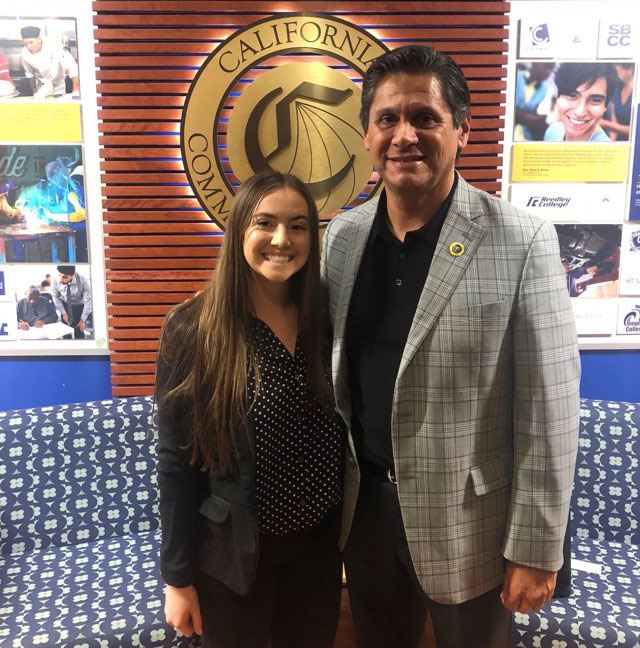
Johnson’s time is also consumed by various student government and advocacy roles, including a campaign to get more University of California students to complete their U.S. Census forms online. “A lot of students have left home and maybe didn’t get the piece of mail that they should have at their campus addresses,” she explained.
In short, Johnson has many plates spinning, like hundreds of thousands of other students who are navigating the shift to online learning the best they can while maintaining their social and interpersonal responsibilities.
“This is not a Coronacation,” she said, referencing the social media hashtag mashing “Coronavirus” with “vacation” that has taken off since the pandemic pushed millions of Americans indoors. “I am busy.”
Get stories like these delivered straight to your inbox. Sign up for The 74 Newsletter

;)